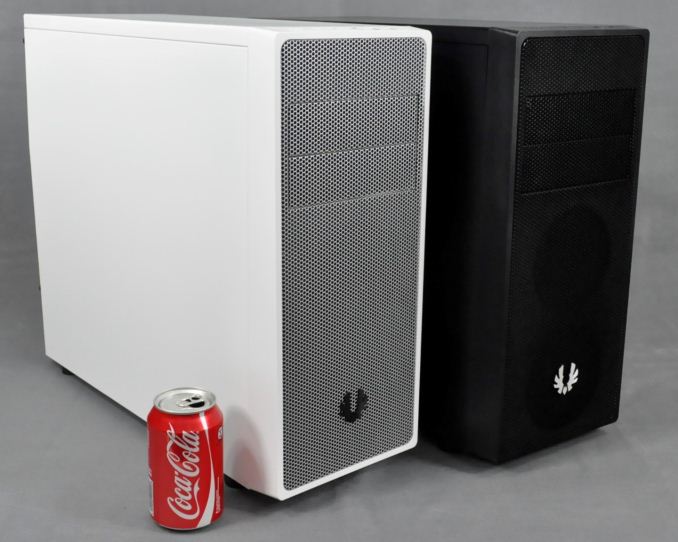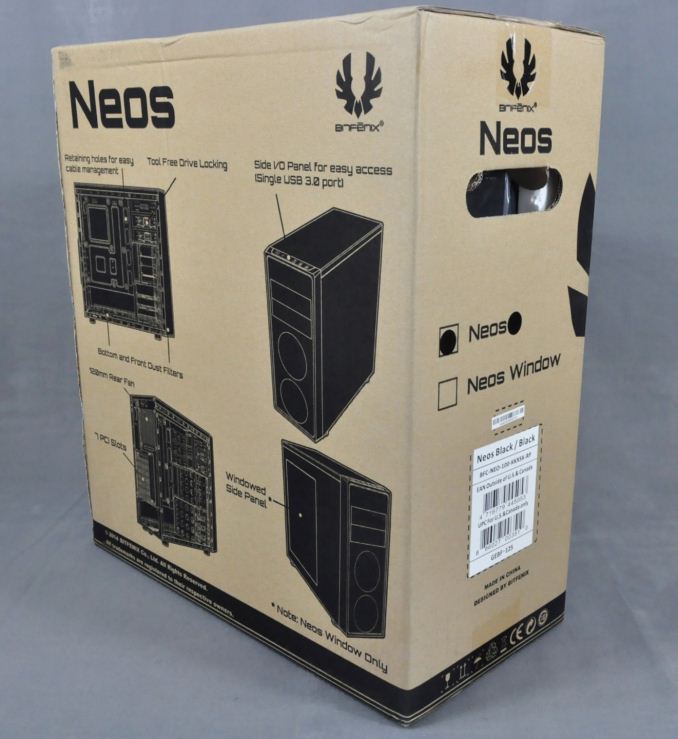BitFenix Neos Case Review
by E. Fylladitakis on January 21, 2015 9:00 AM EST- Posted in
- Cases/Cooling/PSUs
- bitfenix
- Case

Introduction
Naturally, most manufacturers are inclined to have their best products reviewed, as a high-cost product is less likely to have many flaws and it's easy to leave the average user awestruck, promoting the company name. However, the bulk of the revenue of most companies comes from their "mainstream" products, where the target market is many times larger than that of enthusiasts and highly advanced users. In the past several months, we've had the chance to have a look at several advanced cases, some designed for performance while others were meant for special applications. Today we are going to have a look at a standard Mid-ATX case with a price tag of about $60, the BitFenix Neos.
BitFenix is no stranger to AnandTech. Many of their products have been through our labs, from the $39 Merc Alpha to the $159 Shinobi XL, each with its own target group, strengths, and weaknesses. The BitFenix Neos that we are reviewing today aims to be an affordable, simple, and stylish case. It can be found selling from about $50 to $75, depending on the color configuration. Two chassis are available, either black or white, but there is a large selection of faceplate/mesh colors for either chassis, including black, white, red, bronze, silver, gold, blue, and purple.
12 oz. Coke can for size comparison.
| >BitFenix Neos Specifications | ||
| Motherboard Form Factor | ATX, Micro-ATX, Mini-ITX | |
| Drive Bays | External | 2 x 5.25" |
| Internal | 3 x 3.5" (front drive cage) 3 x 2.5" (front drive cage) | |
| Cooling | Front | 2 x 120 mm (optional) |
| Rear | 1 x 120 mm (included) | |
| Top | - | |
| Left Side | - | |
| Bottom | - | |
| Radiator Support | Front | - |
| Rear | 120 mm | |
| Top | - | |
| Side | - | |
| Bottom | - | |
| I/O Port | 1x USB 3.0, 1x USB 2.0, 1x Headphone, 1x Mic | |
| Power Supply Size | ATX | |
| Clearances | HSF | 155 mm |
| PSU | - | |
| GPU | 310 mm | |
| Dimensions | 429 mm × 185 mm × 470 mm (H×W×D) 16.89 in × 7.28 in × 18.5 in (H×W×D) | |
| Prominent Features | Front Dust Filter PSU Dust Filter Tool-Free Drive Locking | |
| Price | $50 to $75, depending on the color configuration | |
Packaging and Bundle
BitFenix supplies the Neos in colorless, brown cardboard boxes. Illustrations on the box depict the most important features of the case. Inside the box, the lightweight case is very well protected by thick styrofoam slabs and a nylon bag. As for the bundle, we are not going to delve much into it, simply because there is virtually nothing noteworthy supplied with the Neos. With the purchase of this case, the user will only receive a basic manual and the necessary screws in a small nylon bag.












54 Comments
View All Comments
YoloPascual - Wednesday, January 21, 2015 - link
Outclassed by the Corsair 100R.mischlep - Wednesday, January 21, 2015 - link
Minor typo, page 3: "nearly as much as a generic low cost Midi-Tower case"Should probably be a "Mid-Tower case"
mr_tawan - Wednesday, January 21, 2015 - link
This case might target digital musician :-).SleepModezZ - Wednesday, January 21, 2015 - link
'Midi tower' is a term in common use. It means the same as 'mid-tower' but is more used outside of US. The same tower cases that are classified as 'mid towers' on amazon.com are classified as 'midi tower' on amazon.co.uk. Even on amazon.com many descriptions calls a case a 'midi tower' although it is named a 'mid tower' in the big title. So maybe 'midi tower' is the proper term and 'mid tower' is what came of it after Americans butchered it?JarredWalton - Thursday, January 22, 2015 - link
For computer components, a large number of terms originated in the US market so we could hardly have "butchered" it, right? Anyway, given E. is located in Europe his use of "midi-tower" is completely acceptable, but for our US readers I went ahead and changed it to "mid-tower". Midi files... does anyone still use those? I remember back in the late 80s and early 90s where high quality Midi sound modules like the Roland MT-32 were the best way to listen to Midi. Good times! (And my MT-32 only cost about $600 all told. Ouch. So no, I don't miss those days.)SleepModezZ - Thursday, January 22, 2015 - link
You are right, I forgot to put a smiley after my last sentence.dragosmp - Wednesday, January 21, 2015 - link
I imagine a bottom-mounted extra fan would help quite a bit, but for the money they ask this case should be betterMurloc - Wednesday, January 21, 2015 - link
it's like they looked for a chinese factory that's not done a single upgrade since the 90s and made them make a case that looked decent.I mean, you could sell cases without expansion slot covers to PC companies that build computers which are not meant to be further tampered with, but if you're selling a case directly to users it needs to be a bit more future proof.
FriendlyUser - Wednesday, January 21, 2015 - link
Great review. I would suggest adding a 250W thermal load, corresponding to a mid-level machine with something like a 750Ti and a 65W CPU. Also, I would be curious to see when the case reaches equilibrium. I don't know if technical reasons require a failsafe cut-off, but I think you could maybe let it run up to 100C or try a cooler environment.SleepModezZ - Wednesday, January 21, 2015 - link
I would suggest an even lower thermal load to simulate systems that are not build for gaming. I have my computer in a quite similar sized case. Kill-a-watt shows that it is drawing 60 - 110 W. The idea of testing every case like it is meant to house a 850W or 400W gaming monster and then judge them based on their obvious failings is silly.The graphs compare the case to other better cases without mentioning that they are at least 50% bigger in size and probably also at least as much pricier. Those facts alone might make the Neos a better choice for those who are not planning to put in it anything even close to 850 or 400 Watts and wants a decent looking case . (Actually many cheap cases look really bad - they either look like toys for prepubertal boys or black and silver plastic cases for workplaces or people that do not care at all about the looks of the case.) The difference in thermal performance compared to to bigger and pricier gaming cases probably will not have any practical meaning when going to the sub 200 W range. The Neos is clearly not meant for gamers or overclockers so it should not be evaluated like such a case. The noisy fan is a real bummer but it could be replaced with a better fan, and there is place for 2 more 120mm fans on the front of the case if a bit better thermal performance should be needed. The only practical information in this review for someone like me who might actually consider this case, is that the metallic mesh might easily be damaged, that the expansion slot covers are what they are and I probably would have to change the fan for a less noisy. What about the HDD noise?